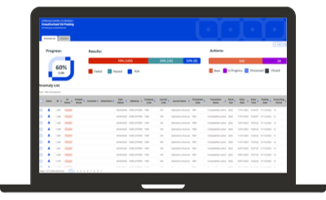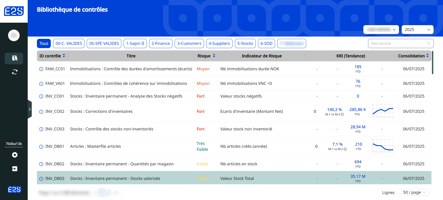Starting a new role as an internal audit and control manager is a critical transition, especially...
How to Successfully Onboard as an Audit and Internal Control Manager [1/3]
Taking on a role as an audit and internal control manager represents a decisive moment for both the professional and the organization. Successfully onboarding in this position during the first 90 days is critical, as these initial months often shape the future trajectory of the function in an environment with high expectations and significant challenges.
Imagine yourself leading an audit and internal control department in a company with over 10,000 employees, in an industry you know little about. Before you lies a complex mosaic: different ERP systems across regions or subsidiaries, dozens of business applications, and processes that vary by country and division. This function may not have existed before you, or was simply viewed as a compliance obligation rather than a department that should deliver real added value. In this context, the challenge is twofold: gaining an in-depth understanding of the company while quickly demonstrating concrete results.
Navigating Complex Information Systems: Your First Onboarding Challenge
The multiplicity of information systems is often the first obstacle to overcome.
"When I arrived, I discovered that each region had its own ERP, some sites were still using legacy systems, and data was scattered in different formats," shares an audit director of a food processing company.
This once-paralyzing situation now finds solutions through data analytics tools like Eye2Scan, which allow you to centralize and analyze data regardless of its source—while also saving you from lengthy training on each tool.
Strategic Field Immersion: Essential for Audit Leadership Success
Field immersion is an essential first step that must be structured to balance understanding and action. This observation period becomes a strategic opportunity to establish the foundations for your success.
Initial exchanges with teams are essential for building the credibility of the function. By involving yourself in operational discussions, you demonstrate your role as a facilitator rather than just a controller. This approach helps identify the first gaps between theoretical procedures and their actual application, while raising awareness among teams about the importance of controls.
"The first six months are dedicated to understanding the challenges, establishing key relationships, and implementing the first automated controls. The period from six to nine months allows us to capitalize on the identified quick wins and strengthen critical processes," explains this same newly appointed audit director.
To maximize the effectiveness of this immersion phase, it's essential to adopt a methodical approach. Meetings with managers from different departments help understand their specific challenges and daily difficulties. Direct observation of processes in the field often reveals informal practices and weaknesses that don't appear in reports. By cross-referencing these observations with objective data analysis, you can establish an accurate and relevant risk mapping.
Data-Driven Audit Approach: Accelerating Your Initial Impact
Data is now a vital pillar of modern audit and internal control. Advanced automation and data analytics tools quickly allow you to:
- Consolidate data from multiple sources (entities, ERPs, business applications)
- Automatically detect anomalies in substantial data volumes thanks to a vast selection of off-the-shelf controls
- Prioritize actions based on identified risks across different cycles: Purchasing, Sales, Inventory, SOD
- Concretely measure the impact of implemented controls
This data-driven approach transforms how a new director can approach taking office. Instead of starting from scratch, they can quickly rely on objective analyses to guide their actions.
Building Strategic Internal Audit Alliances Across Departments
The success of taking on a new position largely relies on the ability to create alliances within the organization:
- With Risk Management to orient controls according to risk mapping
- With Financial Management for reviewing accounting processes and improving financial statement reliability and risk analysis
- With Compliance to coordinate controls and ensure regulatory adherence
- With IT to facilitate system access and tool deployment
- With Operations (process owners) to strengthen the first line of defense and deliver real added value
Having a tool like Eye2Scan helps this collaboration by bringing all stakeholders together around the data and gives you a comprehensive and traceable view of all actions.
Success in a new position isn't measured solely by the controls put in place, but also by the ability to create a collaborative ecosystem. An experienced director shares:
"Our greatest success wasn't technical, but human. We managed to transform the perception of internal audit, shifting from a control function to a performance partner."
Quick Wins Strategy for New Audit Leaders: Accelerating Visible Results
Identifying and executing "quick wins" requires a subtle balance between visible impact and rapid feasibility. These early successes are essential for several reasons:
- Quickly demonstrating tangible results to senior management
- Enhancing the function by showing that audit and internal control are sources of process improvement and optimization, not just compliance constraints
- Creating a climate of trust with operational teams by involving them in concrete solutions and considering an exchange of best practices
- Maintaining positive momentum and capitalizing on a sense of progress from the first months in the position
Data analysis is an essential lever for identifying relevant quick wins. With data analytics tools like Eye2Scan, it's possible to quickly detect anomalies and transform them into concrete, high-value actions. By cross-referencing these results with field observations, you can prioritize your first interventions and quickly demonstrate tangible impact. We invite you to read our article "How to Demonstrate Your Value (ROI & KPIs) During Your Trial Period in Audit and Internal Control" for concrete examples of controls.
Here are two concrete examples explaining how this recently appointed audit and internal control director approached this challenge:
"Through interviews, we initially identified the absence of a physical inventory procedure. The teams had started drafting it, but it had never been finalized or validated. By taking up the subject with them and collaborating closely, we were able to arrive at a complete and validated version in just a few weeks. Then, one month after distributing the inventory procedure, using Eye2Scan quickly allowed us to ensure that initial inventory discrepancy records had been properly registered, which proved the effective completion of the first inventories carried out across several sites."
"Using Eye2Scan, we quickly detected duplicate invoices. This analysis allowed us not only to identify immediate potential savings but also to demonstrate the added value of internal control in improving financial processes."
Building a Robust 90-Day Audit and Control Roadmap
A balanced audit leadership roadmap should be structured around three complementary time horizons. The first 90 days are dedicated to understanding the organizational challenges, establishing key stakeholder relationships, and implementing the first automated controls using tools like Eye2Scan. The period from three to nine months allows capitalizing on identified quick wins and strengthening critical control processes. Beyond that, the objective is to deploy a more structured, continuous, and collaborative internal control program that delivers ongoing value to the business.
Successful Audit Leader Onboarding: Balancing Understanding and Action
Successfully onboarding as an audit and internal control leader requires balancing in-depth organizational understanding with rapid, visible action. Experience shows that effective audit leaders don't wait for an exhaustive vision before beginning to implement controls. Data analytics tools like Eye2Scan significantly accelerate this critical startup phase by providing a clear view of risks and improvement opportunities across your control environment. This strategic approach not only allows you to quickly demonstrate your added value as an audit leader but also lays the foundation for sustainable transformation of the control function—an excellent way to convince senior management and turn your trial period into a demonstrable success! 😉
In short, the key to successful audit leadership onboarding lies in combining proven internal control methodology with the possibilities offered by automation technology like Eye2Scan, while maintaining a strong human orientation that builds trust with stakeholders. Our next article in this series will present a selection of strategic audit controls and KPIs that will allow you to quickly transform these onboarding challenges into concrete results, thus enriching your arsenal of quick wins from the first 90 days of your audit leadership mission.



